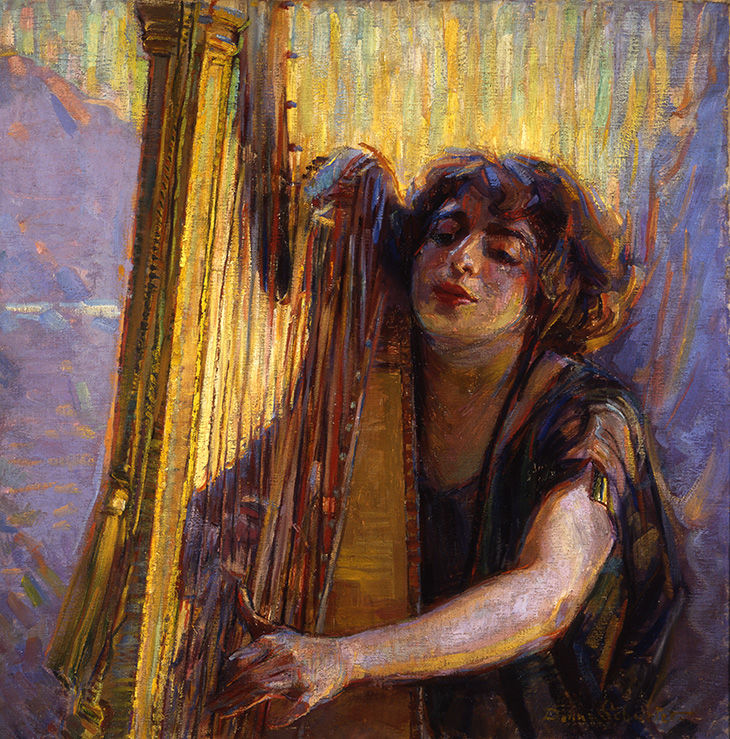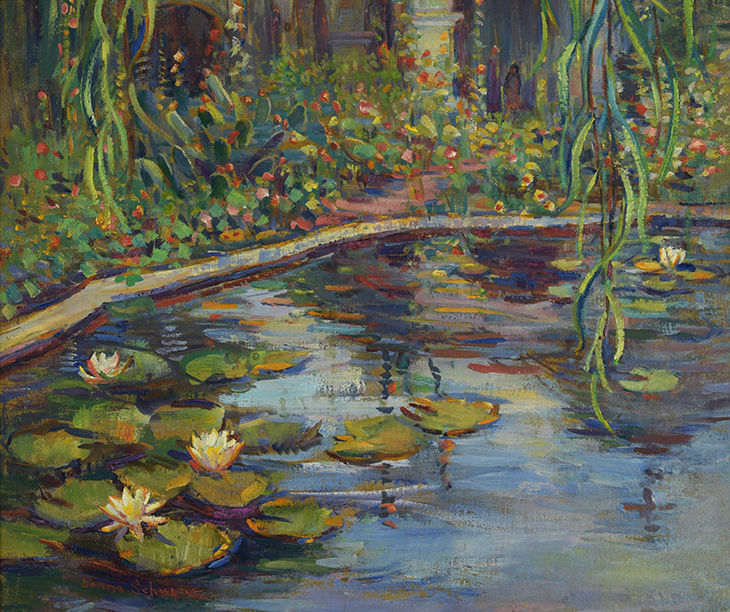Donna Schuster, “An Independent Brush”
- Democracy Chain

- Aug 12
- 4 min read
by Liz Goldner
Laguna Art Museum, Laguna Beach, California
Continuing to September 7, 2026

Donna Schuster (1883-1953) excelled at painting portraits of confident, beautiful women, relaxing, dining, enjoying the outdoors, taking care of business and playing instruments. These paintings, many created during the suffragette movement, reveal Schuster’s admiration for females who had the independent spirit that she was also known for.
The show’s subtitle, “An Independent Brush,” conveys Schuster’s progressive, multi-faceted approach to artmaking. She became known for her use of rich colors, expressive brushstrokes and bold experimentation with watercolors and oils. Her work was notable for its incorporation of new modernist styles, including Impressionism, Cubism and abstraction.

An independently wealthy native of Wisconsin, Schuster never married, devoting her life to creating and teaching art and promoting her own work. She studied at the Art Institute of Chicago, and graduated with honors from the Boston Museum of Fine Arts. William Merritt Chase was a mentor whom she accompanied on a painting tour of Belgium in 1912. Her early arts education emphasized the impressionist style, particularly the work of Claude Monet. In Southern California during the late 1920s she studied with Stanton MacDonald Wright, co-founder of the Synchromist movement, which sought to evoke emotions and musical sounds through visual art incorporating cubist and abstract elements.
“Le Petit Dejeuner” (1912) is an early work painted in a lightly colored impressionist style. It depicts a young French woman enjoying her breakfast. Two other paintings from that period are “The Black Hat (Self-Portrait)” and “Self Portrait with a Cat” (both 1912). Each work is dark in tone, with the former impressionistic in style, and both reveal the budding artist’s profound figurative skills and confident manner.

After moving to Southern California in 1913, Schuster celebrated the sunshine and the beach in works such as “On the Beach” (1917), a classic portrait of a beautiful woman holding a large parasol, her eyes focused to her right. Painted with bold colors and strong contrasts of light and dark, it has a contemporary feel. Also noteworthy is “Girl in a Hammock” (1917), of a young woman relaxing in the late afternoon, gazing languidly at the artist. “Summer Idyll” (1922) is a close-up of a young woman in profile, also in a hammock, reading a book, all lit by California’s golden light. Each painting individualizes emotion and generously depicts the SoCal lifestyle.
Another notable portrait is “O’er Waiting Harp Strings” (1921), whose subject is an attractive woman of privilege passionately playing her harp. The dark tonalist-style shadows playing on the woman’s body, face and hair contrast with the golden hues of the harp strings and the sunlight streaming through a large window. As Schuster had traveled to Northern California in 1914 and 1915 to study with Chase and to participate in San Francisco’s Panama-Pacific International Exposition, she undoubtedly became acquainted with the tonalist art movement, which emphasized a richly colored atmosphere.

At the Panama-Pacific Exposition, Schuster painted scenes of buildings under construction. One of those paintings, the gouache “Panama-Pacific International Exposition, Fine Arts Pavilion” (1915), graces this exhibition. Writing in the Los Angeles Times at the time, Antony Anderson noted that these paintings caught the spirit of San Francisco, including its joyous lifestyle and glamorous sunshine. Schuster was also a member of the Group of Eight who, from 1921-28, were known for their free use of color and their figurative work that embraced elements of early modernism.
As Schuster progressed in her development, she segued to illustrating indoor and outdoor scenes, with each painting combining various art styles. ”Evening, Los Angeles Harbor” (1929) expresses the movement of the boats and water. “Checking the Nets” (no date) draws our attention to several sailboats lined up, with sailors checking the nets, the artist’s brush conveying the vibrancy of life at the harbor.

Schuster employed Impressionist technique frequently. “Lily Pond, Capistrano Mission” (1928), with water lilies alongside the mission gardens, pays homage to Monet. She used this style in several other bucolic canvases, including “The Mission Bells,” “On the Veranda” and “Houses, Silver Lake” (all undated). Several undated still lifes, including “Gourds and Russet Pears,” “Samovar on the Table,” and “Still Life with Blue Bowl” demonstrate Schuster’s knowledge of modernism, expertise in figuration, aggressive use of color, and skill in creating harmonious designs.
By the time Schuster passed away in 1953 (due to an accident), she had produced an abundance of magnificent paintings emphasizing the special qualities of the California lifestyle and tracing the progression of art styles during the first half of the 20th century.
Liz Goldner is an award-winning art writer based in Laguna Beach. She has contributed to the LA Times, LA Weekly, KCET Artbound, Artillery, AICA-USA Magazine, Orange County Register, Art Ltd. and several other print and online publications. She has written reviews for ArtScene and Visual Art Source since 2009.





Commentaires